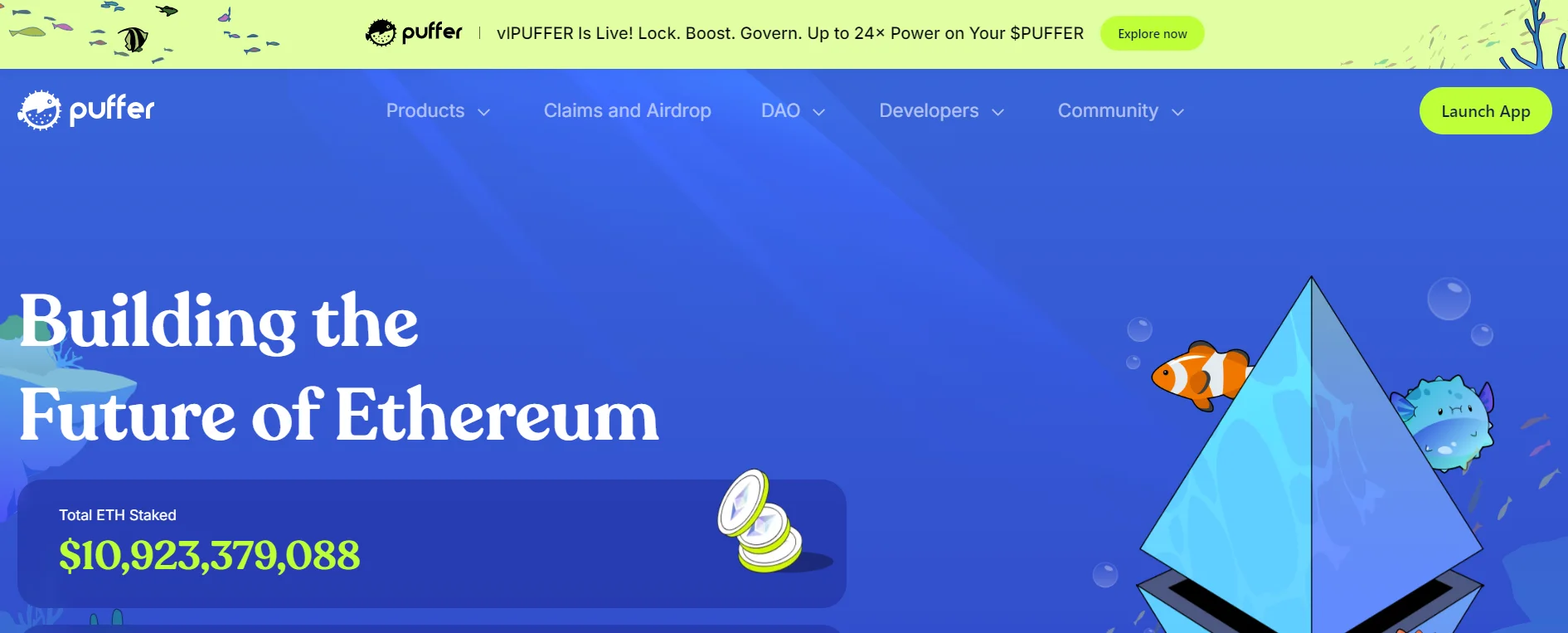Puffer Finance — is an advanced ecosystem built on Ethereum that combines liquid restaking technology, decentralized validation, and near-instant transaction confirmations. The project offers the pufETH token, representing cumulative rewards from staking, restaking, and participation in network services. Using Validator Tickets, Puffer creates a market for validator rights, lowering the entry threshold to 2 ETH while maintaining transparency. Additionally, the team develops UniFi and Preconf solutions, turning Ethereum into a platform capable of millisecond-level confirmations.
- Concept and Goals of Puffer Finance
- nLRP Architecture and the Role of Validator Tickets
- pufETH Token Economy
- Security and Secure-Signer Technology
- UniFi and Puffer Preconf: The Era of Instant Transactions

Concept and Goals of Puffer Finance
Puffer Finance emerged as a response to the limitations of traditional Ethereum staking, which requires a high deposit and strong technical expertise. The team’s mission is to make validation accessible to everyone without compromising network security.
The project’s main idea lies in merging the advantages of liquid staking and native restaking. Users can deposit ETH or its derivatives (stETH, wstETH) and receive the pufETH token, which appreciates over time relative to ETH as rewards accumulate. This token becomes a flexible instrument in DeFi — it can be used as collateral, traded, or restaked again.
Moreover, Puffer aims to remove the gap between institutional validators and individual users. With its hybrid architecture, smaller participants can earn validator-level yields without running their own nodes. This creates a fairer and more decentralized Ethereum ecosystem, empowering all users equally.
nLRP Architecture and the Role of Validator Tickets
At the core of the protocol lies nLRP (Native Liquid Restaking Protocol), integrating pufETH tokens, validators, and the Validator Tickets (VTs) system.
Main elements of the Puffer Finance architecture:
- pufETH — a liquid token representing cumulative rewards from staking and restaking.
- Validator Tickets (VTs) — tokens granting operators the right to run and maintain a validator for a defined period.
- NoOps — independent validators requiring only 2 ETH and a set of VTs to launch a node.
- Restaking Module — a smart contract managing validator pools and syncing with EigenLayer to distribute rewards.
- Reward Flow — a system through which profits from VT sales and validator operations are shared with pufETH holders.
The nLRP design balances efficiency and decentralization. Instead of relying on centralized operators, it distributes responsibility among multiple independent validators, reducing single points of failure. This structure creates an open infrastructure where anyone can become part of the validator layer. Validator Tickets add flexibility by allowing users to buy, sell, or hold them, optimizing yield according to market conditions.
pufETH Token Economy
The pufETH economy is based on a multi-layered model combining income from staking, validator ticket sales, and DeFi participation. Each revenue stream strengthens token sustainability and makes it appealing to both investors and network operators. Unlike standard LST tokens, pufETH aggregates not only validator rewards but also restaking premiums through EigenLayer, becoming a dynamic income asset.
In addition, the transparent on-chain structure allows users to monitor real-time reward accruals, building trust and encouraging long-term holding. This model creates a self-sustaining economy where validator efficiency directly impacts pufETH growth.
| Revenue Source | Description | Impact on pufETH Yield |
|---|---|---|
| Base ETH Staking | Rewards from block production and transaction fees on Ethereum | Forms the core APR component |
| Validator Ticket Sales | Revenue from issuing validator operation rights | Boosts overall pufETH holder returns |
| Restaking via EigenLayer | Rewards from Active Verification Services (AVS) | Adds a variable income layer |
| MEV and Execution Rewards | Profit from transaction optimization and block production | Increases validator and pufETH efficiency |
| pufETH Liquidity | Participation in DEX and DeFi protocols | Creates additional market demand |
This structure makes pufETH one of the most flexible assets in Web3. Its value grows dynamically through diversified income channels beyond simple staking yields. Even amid market volatility, the model remains resilient due to multiple revenue sources. Full on-chain transparency allows users to verify rewards at any time, reinforcing trust and stability within the ecosystem.
Security and Secure-Signer Technology
Puffer’s security framework is built around the Secure-Signer solution based on Intel SGX technology. It ensures validator key protection and prevents errors that could trigger slashing penalties.
The technology operates through a three-layer defense model:
- Key Isolation: validator data is stored in an encrypted SGX enclave, fully inaccessible externally.
- Signature Filtering: only valid, non-slashable transactions are permitted.
- Attestation Proof: provides cryptographic verification of the trusted execution environment to external entities.
This framework builds strong validator reliability while minimizing human error. Secure-Signer also appeals to institutional participants requiring compliance-grade security. The Puffer team is expanding support to additional TEE technologies, such as AMD SEV, ensuring compatibility and network-wide resilience.
UniFi and Puffer Preconf: The Era of Instant Transactions
Beyond restaking, Puffer is developing UniFi — a Layer-2 solution that inherits Ethereum’s security while matching centralized systems in speed. At its core lies Puffer Preconf, a mechanism that enables transaction confirmations within ~100 milliseconds.
Preconf operates on a “pre-consensus” principle: transactions gain instant confirmations backed by economic guarantees. If an operator violates protocol rules, their stake is burned. This bridges Web2 responsiveness with Web3 integrity.
Through UniFi, Puffer extends far beyond a restaking protocol to become a comprehensive technological platform. Its potential applications span DeFi, gaming, and social Web3, where speed is critical. In the future, Puffer plans to use UniFi as the foundation for new network-level services, positioning itself as a key player in Ethereum’s infrastructure evolution.




